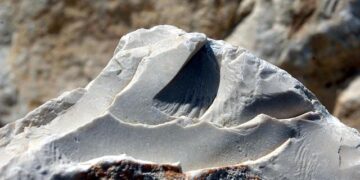For over a century, we’ve turned to technology in an attempt to control the weather. Are today’s geoengineering proposals any better?
By
Bill Gourgey
|
Published Apr 29, 2024 9:53 AM EDT

An October 1919 Popular Science story described hail cannons and similar technological efforts to alter weather patterns. Popular Science
From cities in the sky to robot butlers, futuristic visions fill the history of PopSci. In the Are we there yet? column we check in on progress towards our most ambitious promises. Read more from the series here.
Around the turn of the last century, more than 12,000 cannons were installed across Europe. This particular form of artillery was no prelude to World War I. Rather, the massive, cone-shaped barrels were pointed at a common ancient enemy: approaching storm clouds. Sometime in the 1890s, firing hail cannons at the sky overtook alternatives, such as ringing church bells, to ward off crop-damaging hail storms.
An October 1919 Popular Science story described hail cannons and similar technological efforts to alter weather patterns. At the time, the newest climate-fighting arsenal included “Electric Niagaras,” tall steel towers fitted with copper lightning rods to draw power from the sky and prevent hail formation; liquefied carbonic gas bombs detonated in the sky to induce rain; and balloons “equipped to produce electrical discharges” at high altitudes to ionize the atmosphere and “promote condensation.” Some of the proposed schemes outlined in the 1919 article went beyond local or regional aspirations, with enthusiasts setting their sights on planetary engineering ideas like altering the Jet Stream by igniting hundreds of fires across the western US to influence wind direction and steer weather to the east, or protecting the coast-warming Gulf Stream from polar water by building an enormous jetty between the US and Canada.
Humans have been trying to influence weather and climate since antiquity. Until the late 19th century, however, such attempts mostly took the forms of ritual dances, spells, and divine offerings. Hail cannons signified a pivot toward technology for its potential to offer a more reliable alternative. But technology’s track record has been spotty at best, despite a long succession of attempts, including significant cloud seeding trials that persist to this day but got underway in earnest in the 1950s and 1960s in the US, China, and former USSR.
In the 21st century, as evidence mounts that human activity has set the planet on a dangerous warming trend and that cutting greenhouse gas emissions may not be enough to avoid devastating effects from global warming, some scientists, engineers, and climate activists are increasingly promoting the familiar climate-intervention playbook. But are today’s proposals to manipulate Earth’s climate any better?
Taking climate control with technology
“Geoengineering is the intentional large-scale manipulation of the environment, particularly manipulation that is intended to reduce undesired anthropogenic climate change,” according to a 2000 report by David Keith, now a geophysical scientist at the University of Chicago, and Founding Faculty Director, Climate Systems Engineering Initiative.
Wake Smith, author of Pandora’s Toolbox: The Hopes and Hazards of Climate Intervention, and a Lecturer at the Yale School of the Environment, claims that there are lots of impractical geoengineering schemes circulating, like “painting deserts white, putting bubbles on the sea, and cirrus cloud thinning.” But Smith believes there are a couple of ideas, grounded in nature, worth considering. “The two sides of our toolbox are carbon capture on the one end, and sunlight reflection, which really means stratospheric aerosol injection (SAI), on the other,” Smith says. He cites marine cloud brightening as another possible contender.
Other proposed geoengineering approaches for tackling climate change include (more) cloud seeding, cloud thinning, ocean salting, and ocean whitening. Besides carbon capture, however, none of these mitigation strategies are being implemented, and not even carbon capture, which involves sucking greenhouse gasses from the air or trapping them before they’re emitted, is being implemented widely.
Tinkering with scale
Even in the 21st century, planetary engineering still seems like the stuff of science fiction. But if, over the course of the next decade or so, climate scientists and engineers really do make significant progress toward such technology, it’s worth considering how it might be controlled.
For instance, the first knob on a planetary Climate Control Mixer might be labeled “Scale.” Nineteenth century efforts, like hail cannons, would register in the low range as localized reactive measures. Dial up the knob to its midrange to achieve weather control on a regional level, like the cloud seeding trials started in the mid-20th century and still underway today. For 21st century planetary thermostat proposals, crank the knob all the way to its max setting—geoengineering.
But to tune Earth’s climate efficiently, a well-oiled Climate Control Mixer would need at least a few more knobs, faders, and buttons. Which solution to deploy might be dictated by swiping up or down an “Interference” fader, whose settings range from passive to active. The more passive a solution, the lower the chances of it backfiring, but it also might be less effective.
Passive versus active control
For instance, direct air capture—sucking carbon out of the ambient environment and pumping it underground—represents one of the more passive forms of geoengineering. Several startups, like CarbFix, CarbonFree, and Climeworks, have already built direct carbon capture facilities and are piloting and deploying solutions. The catch is the timeframe and inefficiency. While Smith believes that carbon capture should be deployed widely—without delay—especially to filter emissions from factory flues, “it will take a century or two,” he says, “to capture from direct air, the amount of carbon that would be needed to return the climate to something like its pre-industrial state.” Even at scale, carbon capture is not an alternative to reducing GHG emissions.
SAI, a form of solar geoengineering, would be on the active end of the “Interference” range. SAI got its inspiration from naturally-occurring geological phenomena—volcanic eruptions. Very powerful eruptions, which have occurred once or twice a century, can belch sulfur-laden plumes all the way into the stratosphere, 4–12 miles above Earth’s surface, spreading a fine layer of particles that reflect sunlight into space. Following Mount Pinatubo’s 1991 eruption, Earth experienced a cooling effect of nearly one degree Fahrenheit for a year.
“We’re pretty confident that [SAI] would really work,” says Smith, “because of Pinatubo, Krakatoa, and Tambora.” While such violent, sulfur-spewing eruptions are known to cool the planet, they can also have side effects like significant changes in global precipitation patterns, ozone depletion, and causing acid rain and respiratory distress for some. Smith makes the case, however, that unlike other geoengineering suggestions, with SAI most of the consequences are known. “Volcanoes don’t eliminate all risks,” he notes, comparing SAI with naturally occurring eruptions, “but they dramatically reduce the likelihood of unintended consequences.”
Marine cloud brightening, another active solution, also takes its cues from nature. In some places on the planet, mostly over the ocean, natural aerosols like salts get tossed in with clouds, causing them to reflect more sunlight away from Earth. Ongoing trials in Australia to save the Great Barrier Reef from excessive ocean warming includes spraying aerosolized salt, pumped from ocean water, into clouds to brighten them. So far, the results have been inconclusive, with significant variation in effectiveness between reef locations.
Cost and speed control
Of course, any proper Climate Control Mixer would have to include knobs for “Cost” and “Speed” along with a pair of high priority feedback gauges to monitor environmental and geopolitical impact. Ratcheting up investment in a passive technology like direct air capture might have negligible geopolitical impact but could take a century or more to begin having an environmental impact, delivering benefits too late to stem global warming. On the other hand, dialing up the dollars for active technologies like SAI might work quickly at much lower cost but the environmental pros and cons might be disproportionate across the globe, as some models already suggest, triggering widespread conflict. Plus, the cost would be recurring to maintain cooling effects.
Still, what distinguishes today’s geoengineering solutions from their 19th and 20th century counterparts are the advances in our science and tools—and our need. Scientists have the benefit of a century’s worth of meteorological data and climate studies, including unprecedented monitoring capabilities to track results. While no one has yet purposefully tried to alter weather patterns or climate globally, it’s more likely than ever that today’s technology, if deployed at scale, could make a difference. After all, we’re in this climate predicament because we’ve already deployed CO2-emitting machinery—like cars, power plants, and factories—at scale and the result has led to rapid warming. In fact, there’s a growing sense that we may be compelled to deploy geoengineering solutions to mitigate the scale of disasters like coastal inundation, catastrophic storms and wildfires, epidemic outbreaks, and mass extinctions.
But geoengineering science is still unproven and the ramifications of interfering with what Earth does naturally via its complex web of tightly coupled ecosystems is, perhaps, no less rash today than in the past.
Coming together for climate
As we continue to race toward the global warming cliff of 2 degrees Celsius above pre-industrial temps, Smith and others are calling for geoengineering trials so that we at least have a sense of what it would take to intervene in Earth’s warming and what the ramifications might be.
“There are no real efforts to develop the technology or to develop the governance infrastructure by which to legitimize the technology,” says Smith. “There’s simply nothing happening.”
The problem is that just to run sanctioned trials requires international diplomacy efforts. A long-planned, small-scale SAI trial by Harvard University scientists (Smith was involved) was recently canceled because an international framework for negotiating geoengineering does not exist and enough groups objected to discourage the governing committee from allowing the trial to move forward.
Against the backdrop of intensifying climate disasters and international inaction, a handful of independent researchers and startups, like Make Sunsets, have already attempted their own non-scientific geoengineering trials. These small-scale, unauthorized trials don’t run the risk of creating widespread environmental fallout, but they do exemplify the fact that any rogue actor or nation unconcerned with diplomacy could take matters into their own hands. It suggests that any responsible Climate Control Mixer should be equipped with a prominent red button labeled, “Press in Case of Emergency”—an exit ramp for runaway initiatives.
But halting geoengineering programs, especially long-running missions, would likely come with its own significant risk known as “termination shock.” Stopping efforts to cool the planet could result in a rapid rebound in temperatures that would shock Earth’s ecosystems, likely with devastating effect.
With so much at stake, the problem with even starting serious geoengineering trials requires deciding who would get to manage a future Climate Control Mixer? Who gets to decide which knobs to turn, when to start turning them, when to dial them down, or when to push the red button?
It would need to be “a multilateral, inter-governmental thing,” Smith says, adding, “it’s utterly impossible to imagine that happening in the real world [today].” That’s because even as climate disasters intensify, Earth’s climate is still relatively hospitable, especially for its wealthiest and most powerful inhabitants. We’ve experienced few climate events disruptive enough to drastically affect millions of peoples’ lives at once, and those that have, such as the 2022 floods in Pakistan, have largely impacted poorer people in the Global South. Meanwhile, the countries most responsible for pumping out the bulk of greenhouse gas emissions have gone comparatively unscathed.
While achieving international unity around climate initiatives has eluded us for more than a quarter century, with failed treaties and only a tentative agreement in place, here’s the thing: When Earthlings get together, we’re able to do amazing things even on a planetary scale. In May 1985, scientists announced that they had discovered an ozone hole above Antarctica, and attributed it to noxious clouds of chlorofluorocarbons or CFCs (invented in the 1920s for refrigeration) that had been gathering in Earth’s stratosphere for half a century. Global governments rallied.
Within two years, the Montreal Protocol treaty was signed by every country on Earth to rapidly reduce ozone-depleting substances like CFCs. It was the first treaty ever to receive such universal ratification. Since then, emissions of ozone-depleting substances have been reduced by 98 percent. And while the Antarctic ozone hole fluctuates year to year, affected by myriad factors such as seasonal temperatures and moisture, an improving trend has been consistent. Experts forecast full recovery by 2070.
After decades of foot-dragging and stymied diplomatic efforts, what will it take for the world’s leaders to rally again, this time to drastically and rapidly reduce carbon emissions, and to at least explore geoengineering options?
“The world broadly still imagines we’re going to avoid climate change,” says Smith. “We are not going to avoid climate change,” he adds. It is already here and likely to get much worse.
Unfortunately—and fortunately—there will be no Climate Control Mixer to turn to in our need. It’s on us to work together to reduce emissions rapidly, to test which geoengineering solutions might offer reasonable trade-offs, and to implement them if or when the time comes.
But as we consider such a course, it’s worth remembering that, to this day, hail cannons are still manufactured and used in isolated pockets, despite no scientific evidence to support that shelling storm clouds works. In at least one important sense, hail cannons offer a cautionary tale: let’s not turn to technology just because we can, let’s rely on science to guide us.

>>> Read full article>>>
Copyright for syndicated content belongs to the linked Source : Popular Science – https://www.popsci.com/environment/geoengineering-are-we-there-yet/































